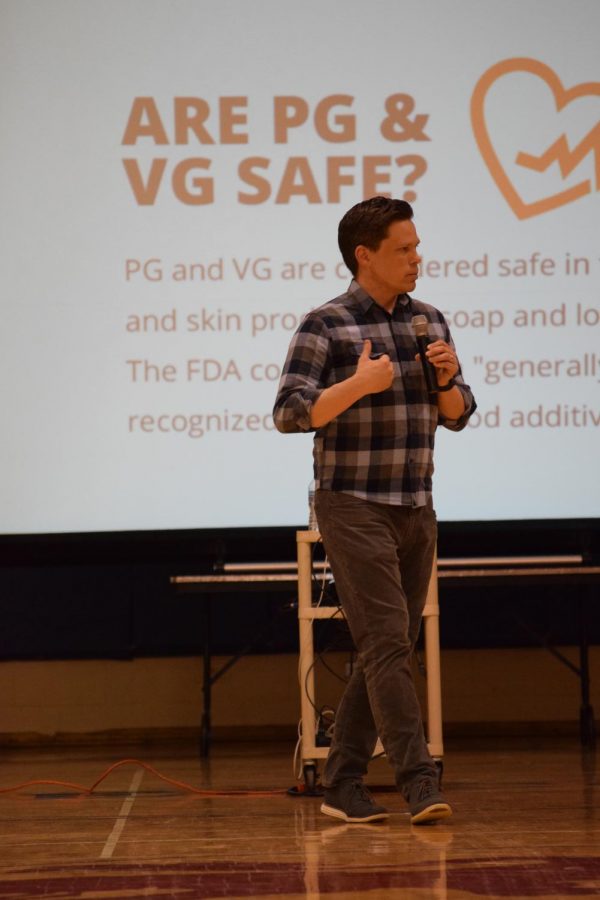Nicotine’s newest guillotine
Administration, SADD club educate on harm caused by vaping
Speaker Andy Duran explains vaping’s detrimental effects.
According to the FDA, there are currently 3.62 million teen e-cigarette users and a 78 percent increase among high school students since last year. The vaping epidemic has spread throughout middle and high school students throughout 2018. In response, school policies have been declared and enforced including at Saint Viator.
According to the student handbook, “Nicotine Product Use – Vaping, smoking and chewing tobacco are demonstrated health risks and prohibited by civil law for minors. Therefore, all products containing nicotine are forbidden before, during and after school in every area of the building, as well on school grounds and at school activities (athletics/co-curriculars). Possession of matches, lighters, or e-cigarette/vaping products constitutes intent and is a violation of the nicotine policy. This includes the use of e-cigarettes, vapor/liquid-based tobacco/ nicotine dispensers and products. A student who violates the smoking/tobacco policy will receive a Saturday detention, including a two week social probation, for a first offense.” More information can be found in the Parent-Student Handbook.
The administration thinks that vaping is an issue now because students may be unaware of the health consequences that e-cigarettes may have in their futures. With more discussion about vaping risks from school speakers and health teachers about the effects of vaping may benefit students by educating them and preventing others from joining in on vaping as well.
“Students and administrators are responding to this issue by debunking the myths associated with vaping and attending the educational program on February 14th to hear Andy Duran, the executive director of Linking Efforts Against Drugs,” said senior Maura Hogaboom.
“They say that vaping is safer than smoking a cigarette, but you are still inhaling chemicals that they do not know of the harm for down the road except the fact that nicotine increases blood pressure and causes heart disease,” said Ms. Lisa Wilson, heath teacher.
At the moment, e-cigarette use has not significantly decreased, and bringing awareness can help limit the number of high school e-cigarette users.
One way that the school increases awareness of the vaping epidemic is through Students Against Destructive Decisions, or the SADD Club campaign against vaping which includes posters around the school discouraging e-cigarette use. “Be cuul and drop the Juul.”
“Students in SADD Club think it is important to address this issue of vaping because we always hope to advocate for healthy decision-making and positive community-building,” said Hogaboom. “We believe vaping is an issue in our high school now because students are not fully educated on the long-term risks associated with the abuse of nicotine and other harmful chemicals.”
“I think it’s important to address this issue because the effects of vaping are not really well known or advertised,” said senior Kiana Resch. “We have found myths and now we’re showing people how they’re myths.”
Two of the most common myths about electronic cigarettes use is that they are less addictive than traditional cigarettes and that they do not contain nicotine. Both of these myths were declared false. Multiple sources such as John Hopkins Medicine discover that e-cigarette users obtain more nicotine than the traditional smoker. According to the Truth Initiative, 63 percent of 15 to 24 year olds were surveyed and were unaware that there is nicotine in vaping products.
The only difference between cigarettes and e-cigarettes is the appeal to a new generation. Vaping is more common by teenagers rather than adults because of the flavors which 81 percent of teen e-cigarette users credit for their use.
Within the school, it is a priority by the administration to enforcing new policies and support SADD Club campaigns to educate students of the myths and consequences of vaping. It is important to be aware of the effects of vaping and the health similarities between e-cigarettes and traditional cigarettes.
“We want to try to help ourselves in the future. We’re not doing it to make anyone feel bad, but we just want to make people realize the effects of vaping,” said Kiana Resch.
Your donation will support the student journalists of Saint Viator High School. Your contribution will allow us to purchase equipment and cover our annual website hosting costs.






